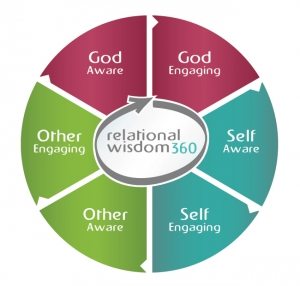 A slightly expanded version of this post is available here.
A slightly expanded version of this post is available here.
God designed us to be three-dimensional in our relationships. Align yourself with this design, and your relationships prosper. Ignore it and they inevitably suffer.
The 3D’s Are Everywhere
From Genesis to Revelation, the Bible teaches us how to relate to God (love, trust, worship, obey), how to engage ourselves (search your heart, self-control, put off/put on), and how to relate to our neighbors (love, forgive, encourage, serve).
Many passages in the Bible address all three dimensions. They start with a focus on God, move on to teach us how to understand and discipline ourselves, then show us how to serve our neighbors. Sometimes they do a full circle and close by focusing our attention on God a second time. For example:
And do not grieve the Holy Spirit of God, by whom you were sealed for the day of redemption.
Let all bitterness and wrath and anger and clamor and slander be put away from you, along with all malice.
Be kind to one another, tender-hearted, forgiving one another,
as God in Christ forgave you (Eph. 4:30-32, ESV; see also Phil. 2:1-11; Matt. 22:27-29).
Frame’s Tri-Perspectivalism
The three-dimensional pattern seen in Ephesians 4:30-32 is found throughout Scripture and creation. It is used over and over by God to communicate the glory of his name and works.
John Frame refers to this concept as “tri-perspectivalism.” As he writes in “A Primer on Perspectivalism,” “In Scripture there is a pervasive pattern of threefold distinctions which, though mysterious, provide us with considerable illumination” (p. 4).
Frame illustrates this point vividly in The Doctrine of God. Appendix A of this book presents a list of 112 triads that occur in Holy Scripture (e.g., the Trinity and the three offices of Christ), non-Christian religion, ontology, epistemology, ethics, and the church, as well as in art, music, literature, and history (see his entire list in this on-line book preview, beginning on page 743).
Stott and Keller Make Three
Frame is not alone in seeing the pervasiveness of triads throughout Scripture and their value in framing our relationships. John R.W. Stott illustrates this pattern in The Message of the Sermon on the Mount:
The three examples of ‘religious’ righteousness which Jesus gives [in Matthew 6:1-18]—almsgiving, praying and fasting—occur in some form in every religion. They are prominent, for example, in the Koran. Certainly Jews were expected to give to the poor, to pray and to fast, and all devout Jews did so….
This trio of religious obligations expresses in some degree our duty to God, to others and to ourselves. For to give alms is to seek to serve our neighbor, especially the needy. To pray is to seek God’s face and to acknowledge our dependence on him. To fast (that is, to abstain from food for spiritual reasons) is intended at least partly as a way to deny and so to discipline oneself (p. 127).
Note that in the latter half of this passage, Stott specifically describes the three dimensions of human relationships (“duty to God, to others and to ourselves”).
Tim Keller makes a similar application of biblical triads in a series of three articles on preaching in the Christian Counseling and Educational Foundation’s Journal of Biblical Counseling. Here is an example of his triadic organization:
Faithful, effective preaching embodies three aspects: the Biblical, the Situational, the Personal. A sermon honors God when a man, from his own heart, applies biblical truth to the hearts of his audience.
Let me put it another way. A preacher is effective when he (1) expounds Scriptural truth accurately, (2) adapts his message to the needs and capacities of his audience, and (3) speaks out of a heart on fire with the Holy Spirit.
These three elements make up any effective ministry of the Word: exposition of Scripture, audience adaption, and personal authenticity. (“A Model for Preaching,” Part 1, p 1; see related teachings in Part Two and Part Three).
These three are not alone. If you read much of Augustine, Luther, Calvin, Spurgeon, or any other noted theologian, you will soon run into similar three-dimensional teaching as they show us how to develop relationships that honor God.
Neglect One Leg and You’ll Suffer
A well-built three-legged stool provides a safe place to sit. But if just one of the legs comes loose or is broken, the stool becomes unstable and will soon toss you to the floor.
The same is true of our relationships. If we pay close attention to what God teaches us about the 3D’s of relationships (how to love him, discipline ourselves, and serve others), our lives are typically more stable, peaceful and fulfilling.
But if we neglect just one of these legs—by forgetting God (1 Sam. 12:9), failing to control our own desires (James 4:1-3), or ignoring those in need (1 John 3:17)—our lives are soon characterized by tension, conflict, and brokenness.
This is one of the major deficits of the popular psychological concept known as “emotional intelligence” or “EI,” a secular version of relational wisdom. By God’s common grace, many EI researchers and practitioners provide valuable descriptive insights into human neurology and behavior. I myself have learned much from them and recommend many of their books.
But because most of these authors ignore the transcendence of God, the effect of sin, the need for the gospel, and the ministry of the Holy Spirit, EI teaching typically lacks the transformative power of the redemptive and relational teachings God has set forth in Scripture.
From Complexity to Simplicity: the SOG Plan
Three-dimensional … tri-perspectival … transcendence. It can all sound terribly complex, abstract, and irrelevant.
 That’s why Corlette and I developed the relational wisdom (RW) paradigm (see diagram to the right). We want to thoroughly explore these crucial yet complicated theological concepts, use them like pillars grounded on the bedrock of God’s Word, and build on top of them a simple, user-friendly, and practical system that organizes the Bible’s teaching on relationships.
That’s why Corlette and I developed the relational wisdom (RW) paradigm (see diagram to the right). We want to thoroughly explore these crucial yet complicated theological concepts, use them like pillars grounded on the bedrock of God’s Word, and build on top of them a simple, user-friendly, and practical system that organizes the Bible’s teaching on relationships.
The simplest application of RW is the SOG plan, which may be summarized as follows: If you want to enjoy stable and rewarding relationships, always seek to be Self-aware, Other-aware, and God-aware (to learn how to apply this concept, see this post).
Whether you’re digging into the deep theology of tri-perspectivalism or applying the simple steps of the SOG Plan, the goal is always the same: to live out the simplest and yet most rewarding relational system ever made, which is to love God with all your heart, and to love your neighbor as yourself … just as Jesus has loved you (Matt. 22:37-39; John 13:34-35).
– Ken Sande
Reflection Questions:
- Which of the three relational dimensions do you do most naturally? Why?
- Which one are you most likely to neglect? How does that effect your daily relationships?
- How do the three dimensions support one another? For example, if you fail to be God-aware, how does that impact your self-discipline and sensitivity toward others?
- If you want to strengthen your relationships, ask God to help you faithfully practice the SOG Plan for thirty days … at which point you will be well on your way to making it a habit.
Finally, if you’d like to accelerate the development of resources to teach relational wisdom, please make an end-of-the-year donation or pledge through our website.
Permission to distribute: Please feel free to download, print, or electronically share this message in its entirety for non-commercial purposes with as many people as you like.
© 2013 Ken Sande
Get this from a friend? Subscribe now!



